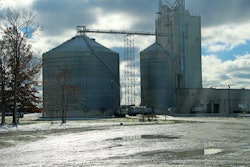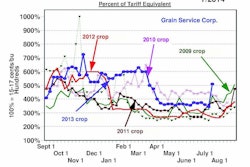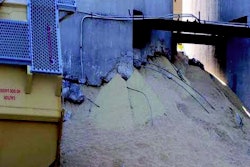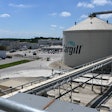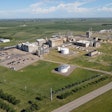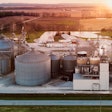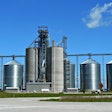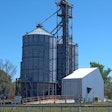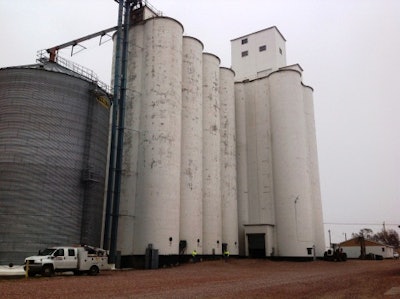
In 2011, A co-op in Sidney, NE, discovered chunks of concrete within one bin of their eight-bin grain silo structure. Upon further investigation, they found a large crack and concrete spalls in the silo wall where the subject bin is connected to an adjacent bin. In addition to structural concerns, the crack and spalls allowed comingling of grain between bins, which was unacceptable to the co-op. The observed damaged conditions required an investigation, design of repairs and the execution of the repairs.
Background
A bronze plaque on a silo wall proclaimed that the co-op's silo was designed and built by Chalmers & Borton in 1954. Unfortunately, original design drawings and construction documents were not available. The structure consists of eight 20-feet-diameter bins that are 120 feet tall with three interior star bins created in the space between the eight circular bins.
The circular bins share two to three common walls with adjacent bins. Thewalls are 7 inches thick and are reinforced with #5 horizontal hoop steel placed at 8 to 14 inches on center. No vertical reinforcing steel was observed in the walls at the repair areas and at several other areas tested with a rebar detector.
The co-op employed Restruction Corporation, a specialist in structural repair and strengthening, to investigate the structure, develop a solution, and execute the repair.
Investigation
All safety requirements for a permitted confined space were implemented. Once inside the silo, we determined the extent of the damage.
The vertical crack and spalling had formed at the intersection of shared bin walls and the corner of the star bin (Photo #1). The crack was 90 feet tall, through-wall-thickness (7 inches), and nominally 3/4 inches wide, creating a path between the circular bin and the star bin. Most of the spalling was in the lower 20 feet of the crack and consisted of vertical slivers of concrete, thus, creating wider voids in the walls between bins.
After we removed the delaminated concrete, we discovered that the exposed horizontal hoop steel had yielded approximately 1.5 inches into the bin at the crack location (Sketch 1, Detail _).
A horizontal crack was also discovered about 2 feet above the intersection of the wall and the conical floor slab at the bottom of the bin. In this lower region of the bin, a strip of concrete, about 1 foot wide, was delaminated on the inside wall parallel to the crack. A 3-feet long section of the wall was damaged full width (Photo #2).
We believe the damage was caused from differential grain load pressures between bins when charging and discharging the grain, differential foundation movements, and lack of vertical steel.
Repair Solution
The repair solution was driven by harvest time schedules and budgets.
For the vertical crack, the solution was to reinforce the cracked and spalled sections of the bin wall to resist imposed horizontal grain loads and repair damaged concrete. To accomplish this we designed the following repair scope (Sketch #1, Sketch Detail and Photo #1).
- Remove delaminated concrete at the along the length of the crack
- Install two vertical reinforcing bars on the spalled side of the crack
- Embed hook bars with epoxy to restrain the new vertical bars at each existing horizontal bar location
- Install a U-bar dowel to restrain the existing horizontal bars on the solid concrete side of crack
- Prepare the concrete surfaces and use the dry shotcrete method to replace the concrete
For the base crack and damage, the solution was to remove all damaged concrete, prepare the concrete surfaces, and use the dry shotcrete method to replace the concrete (Photo #2).
Execution
Safety, always a priority, was especially critical in this confined space with difficult access. In addition, the COOP monitored the air-borne grain dust and maintained the surrounding air quality.
We excavated a 4-feet square hole in the side of the silo just above grade for access and ventilation. The access hole provided good visibility and communication for the outside safety attendant to the work force inside the bin, and sufficient room for equipment transfer.
Duration was also critical on this project because the owner needed the bin available for harvest on or before July 1st. To accommodate this schedule, we erected scaffolding to have access to the entire crack at any one time, as opposed to using a swing stage. Once safety and access were in place, we took the following steps to execute the repair.
- Install ventilation fans and ducts to provide positive air flow within the bin
- Special care was taken to close up the bottom of the bin to make sure none of the outlet works were damaged
- Sounded areas to determine extent of delaminations
- Saw cut concrete to delineate repair areas
- Excavate to sound concrete within saw cuts. For the excavations, we used light 15 lb pneumatic hammers for safety, and to minimize through-wall excavations and surface micro fractures
- At wide spalls, we used small back-up plywood plates and wire screens secured to the bin wall to avoid new concrete falling into the adjacent bin
- Remove excavated debris from bottom of bin
- Sandblast concrete surface in preparation of new repair material
- Install new vertical reinforcing steel
- Drill and install new restraining dowels
- Pre-wet concrete to saturated surface dry condition
- Place shotcrete using our certified shotcrete nozzelman
- Remove safety and access equipment and repair access hole
Repair Success
The owner was very satisfied with the project in two ways. The repair was completed ahead of schedule, without disruption to the owner operation and within the estimated budget. They appreciated working with a contractor who could perform the investigation, design a solution, and execute the repair with its own forces.
Timothy Gumina is President of Restruction Corporation, Sedalia, CO and can be reached at[email protected]. Luis Estenssoro is Senior Project Manager for Walker Restoration Consultants, Greenwood Village, CO, and can be reached at[email protected].





